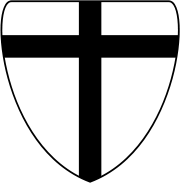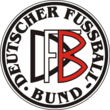
National colours of Germany
Encyclopedia

Black
Black is the color of objects that do not emit or reflect light in any part of the visible spectrum; they absorb all such frequencies of light...
, Red
Red
Red is any of a number of similar colors evoked by light consisting predominantly of the longest wavelengths of light discernible by the human eye, in the wavelength range of roughly 630–740 nm. Longer wavelengths than this are called infrared , and cannot be seen by the naked eye...
and Gold (in practice replaced by a shade of yellow) as seen on the flag of Germany
Flag of Germany
The flag of Germany is a tricolour consisting of three equal horizontal bands displaying the national colours of Germany: black, red, and gold....
of 1849-1852, 1919–1933, and again since 1949. The colors were used by democratic revolutionaries in the early 19th century, and had been used by the Holy Roman Empire
Holy Roman Empire
The Holy Roman Empire was a realm that existed from 962 to 1806 in Central Europe.It was ruled by the Holy Roman Emperor. Its character changed during the Middle Ages and the Early Modern period, when the power of the emperor gradually weakened in favour of the princes...
since the Middle Ages
Middle Ages
The Middle Ages is a periodization of European history from the 5th century to the 15th century. The Middle Ages follows the fall of the Western Roman Empire in 476 and precedes the Early Modern Era. It is the middle period of a three-period division of Western history: Classic, Medieval and Modern...
. Today, these colors are defined by article 22 sec. 2 of the German Grundgesetz
Basic Law for the Federal Republic of Germany
The Basic Law for the Federal Republic of Germany is the constitution of Germany. It was formally approved on 8 May 1949, and, with the signature of the Allies of World War II on 12 May, came into effect on 23 May, as the constitution of those states of West Germany that were initially included...
(Constitution): "Die Bundesflagge ist schwarz-rot-gold." (The federal flag shall be black, red, and gold.)

German Empire
The German Empire refers to Germany during the "Second Reich" period from the unification of Germany and proclamation of Wilhelm I as German Emperor on 18 January 1871, to 1918, when it became a federal republic after defeat in World War I and the abdication of the Emperor, Wilhelm II.The German...
had used Black, White and Red, which derive from the Black cross on White coat carried by medieval crusading Teutonic Knights
Teutonic Knights
The Order of Brothers of the German House of Saint Mary in Jerusalem , commonly the Teutonic Order , is a German medieval military order, in modern times a purely religious Catholic order...
, and the White and Red flag of the Hanseatic League
Hanseatic League
The Hanseatic League was an economic alliance of trading cities and their merchant guilds that dominated trade along the coast of Northern Europe...
. German sports organisations that had been founded prior to World War I have often chosen White with additional Black and/or Red as their colors.
History of Black, Red and Gold
.svg.png)
Coat of arms of Germany
The coat of arms of Germany displays a black eagle on a yellow shield ....
of the Holy Roman Empire
Holy Roman Empire
The Holy Roman Empire was a realm that existed from 962 to 1806 in Central Europe.It was ruled by the Holy Roman Emperor. Its character changed during the Middle Ages and the Early Modern period, when the power of the emperor gradually weakened in favour of the princes...
since the Middle Ages
Middle Ages
The Middle Ages is a periodization of European history from the 5th century to the 15th century. The Middle Ages follows the fall of the Western Roman Empire in 476 and precedes the Early Modern Era. It is the middle period of a three-period division of Western history: Classic, Medieval and Modern...
. Flags in Black, Red and Gold were used e.g. at the coronation of Frederick I, Holy Roman Emperor
Frederick I, Holy Roman Emperor
Frederick I Barbarossa was a German Holy Roman Emperor. He was elected King of Germany at Frankfurt on 4 March 1152 and crowned in Aachen on 9 March, crowned King of Italy in Pavia in 1155, and finally crowned Roman Emperor by Pope Adrian IV, on 18 June 1155, and two years later in 1157 the term...
in 1152. When the Holy Roman Empire was dissolved by Napoleon in 1806, the Habsburg dynasty continued to use the black and gold colors for their Austrian Empire
Austrian Empire
The Austrian Empire was a modern era successor empire, which was centered on what is today's Austria and which officially lasted from 1804 to 1867. It was followed by the Empire of Austria-Hungary, whose proclamation was a diplomatic move that elevated Hungary's status within the Austrian Empire...
.

Lützow Free Corps
Lützow Free Corps was a voluntary force of the Prussian army during the Napoleonic Wars. It was named after its commander, Ludwig Adolf Wilhelm von Lützow. They were also widely known as "Lützower Jäger" or "Schwarze Jäger" .-Origins:...
during the German liberation wars against French occupation under Napoleon also consisted of a combination of black, red and gold. The colors were later used on horizontal tri-colour flags by Lützow veterans and other democratic revolutionaries of the Hambacher Fest
Hambacher Fest
The Hambacher Fest was a German national democratic festival—disguised as a non-political county fair—that was celebrated from 27 May to 30 May 1832 at Hambach Castle near Neustadt an der Weinstraße ....
in 1832, and in the Revolutions of 1848
Revolutions of 1848 in the German states
The Revolutions of 1848 in the German states, also called the March Revolution – part of the Revolutions of 1848 that broke out in many countries of Europe – were a series of loosely coordinated protests and rebellions in the states of the German Confederation, including the Austrian Empire...
. As a result, the German Confederation
German Confederation
The German Confederation was the loose association of Central European states created by the Congress of Vienna in 1815 to coordinate the economies of separate German-speaking countries. It acted as a buffer between the powerful states of Austria and Prussia...
, which had continued the use of the eagle coat of arms in 1815, also adopted the tri-color flag in 1848. It was mainly used in the small Imperial fleet (Reichsflotte
Reichsflotte
The Reichsflotte was the first all-German Navy. It was founded on 14 June 1848 during the Revolutions of 1848 in the German states by the Frankfurt Parliament to provide a naval force in the First Schleswig War against Denmark.-History:...
), which was dissolved by 1852. Because of these traditions, the Weimar Republic
Weimar Republic
The Weimar Republic is the name given by historians to the parliamentary republic established in 1919 in Germany to replace the imperial form of government...
that replaced the monarchy of the German Empire
German Empire
The German Empire refers to Germany during the "Second Reich" period from the unification of Germany and proclamation of Wilhelm I as German Emperor on 18 January 1871, to 1918, when it became a federal republic after defeat in World War I and the abdication of the Emperor, Wilhelm II.The German...
at the end of World War I
World War I
World War I , which was predominantly called the World War or the Great War from its occurrence until 1939, and the First World War or World War I thereafter, was a major war centred in Europe that began on 28 July 1914 and lasted until 11 November 1918...
in 1918 chose Black, Red and Gold both for the tri-color flag and the eagle coat of arms.
.svg.png)
Reichsbanner Schwarz-Rot-Gold
The Reichsbanner Schwarz-Rot-Gold was a Social Democratic paramilitary force formed during the Weimar Republic in 1924....
were founded to defend the colors and the values they represented. Yet, when Adolf Hitler
Adolf Hitler
Adolf Hitler was an Austrian-born German politician and the leader of the National Socialist German Workers Party , commonly referred to as the Nazi Party). He was Chancellor of Germany from 1933 to 1945, and head of state from 1934 to 1945...
came to power in 1933, he quickly abolished the "democratic" colors and made his own Nazi party swastika flag the new national flag of Germany. This Nazi flag used a combination of black, white and red colors, but not in the same way as the old flag of the Empire. Instead, the socialist red was the dominant color.

World War II
World War II, or the Second World War , was a global conflict lasting from 1939 to 1945, involving most of the world's nations—including all of the great powers—eventually forming two opposing military alliances: the Allies and the Axis...
, Germany was occupied and divided. Both new states founded in 1949, the Federal Republic of Germany
West Germany
West Germany is the common English, but not official, name for the Federal Republic of Germany or FRG in the period between its creation in May 1949 to German reunification on 3 October 1990....
(West Germany) and the German Democratic Republic
German Democratic Republic
The German Democratic Republic , informally called East Germany by West Germany and other countries, was a socialist state established in 1949 in the Soviet zone of occupied Germany, including East Berlin of the Allied-occupied capital city...
(East Germany), took up the colors of black, red and gold again, with the GDR adding their socialist symbols in 1959. As a compromise, the Olympic United Team of Germany
United Team of Germany
The Unified Team of Germany , competed in the 1956, 1960, and 1964 Winter and Summer Olympic Games as a united team of athletes from the Federal Republic of Germany and the German Democratic Republic...
, which had first competed in 1956, had to add white Olympic rings to the flag for the games of 1960 and 1964, and also for 1968 when two separate German teams entered under common symbols. After the fall of the Berlin Wall in 1989, East German citizens cut out the socialist symbols of the East German flag in order to show support for a unification with West Germany, which had also continued the use of the traditional eagle coat of arms, called Bundesadler
Coat of arms of Germany
The coat of arms of Germany displays a black eagle on a yellow shield ....
.
History of Black, White and Red

Teutonic Knights
The Order of Brothers of the German House of Saint Mary in Jerusalem , commonly the Teutonic Order , is a German medieval military order, in modern times a purely religious Catholic order...
which had founded the Monastic state of the Teutonic Knights
Monastic State of the Teutonic Knights
The State of the Teutonic Order, , also Monastic State of the Teutonic Knights or Ordensstaat , was formed in 1224 during the Northern Crusades, the Teutonic Knights' conquest of the pagan West-Baltic Old Prussians in the 13th century....
in Prussia. They also used the Imperial black eagle on a gold shield to indicate that they enjoyed Reichsfreiheit
Reichsfreiheit
Imperial immediacy was a privileged feudal and political status, which the estates of the realm such as an imperial city, a religious entity, a feudal principality, or a minor lordship could attain within the Holy Roman Empire...
as direct subjects only to the Holy Roman Emperor.

Ducal Prussia
The Duchy of Prussia or Ducal Prussia was a duchy in the eastern part of Prussia from 1525–1701. It was the first Protestant duchy with a dominant German-speaking population, as well as Polish and Lithuanian minorities...
, which was not part of the Empire. Thus, it became the Kingdom of Prussia
Kingdom of Prussia
The Kingdom of Prussia was a German kingdom from 1701 to 1918. Until the defeat of Germany in World War I, it comprised almost two-thirds of the area of the German Empire...
in 1701. The Prussian coat of arms and flag evolved into a black eagle on white. Since the 18th century, Prussia was often at war with the Austrian Habsburgs that ruled the Empire. Due to this rivalry, the German Confederation
German Confederation
The German Confederation was the loose association of Central European states created by the Congress of Vienna in 1815 to coordinate the economies of separate German-speaking countries. It acted as a buffer between the powerful states of Austria and Prussia...
broke up in 1866. After beating Austria and its Southern German allies in the Austro-Prussian War
Austro-Prussian War
The Austro-Prussian War was a war fought in 1866 between the German Confederation under the leadership of the Austrian Empire and its German allies on one side and the Kingdom of Prussia with its German allies and Italy on the...
, Bismarck founded the North German Confederation
North German Confederation
The North German Confederation 1866–71, was a federation of 22 independent states of northern Germany. It was formed by a constitution accepted by the member states in 1867 and controlled military and foreign policy. It included the new Reichstag, a parliament elected by universal manhood...
which was dominated by Prussia.



Hanseatic League
The Hanseatic League was an economic alliance of trading cities and their merchant guilds that dominated trade along the coast of Northern Europe...
were added. Even though this medieval international trade organization had lost its influence over two centuries earlier, the Free Imperial Cities Lübeck
Lübeck
The Hanseatic City of Lübeck is the second-largest city in Schleswig-Holstein, in northern Germany, and one of the major ports of Germany. It was for several centuries the "capital" of the Hanseatic League and, because of its Brick Gothic architectural heritage, is listed by UNESCO as a World...
, Bremen
Bremen
The City Municipality of Bremen is a Hanseatic city in northwestern Germany. A commercial and industrial city with a major port on the river Weser, Bremen is part of the Bremen-Oldenburg metropolitan area . Bremen is the second most populous city in North Germany and tenth in Germany.Bremen is...
and Hamburg
Hamburg
-History:The first historic name for the city was, according to Claudius Ptolemy's reports, Treva.But the city takes its modern name, Hamburg, from the first permanent building on the site, a castle whose construction was ordered by the Emperor Charlemagne in AD 808...
took pride in their centuries-old Hanse tradition.
The Black, White and Red tri-colour flag of the North German Confederation was carried over to the German Empire
German Empire
The German Empire refers to Germany during the "Second Reich" period from the unification of Germany and proclamation of Wilhelm I as German Emperor on 18 January 1871, to 1918, when it became a federal republic after defeat in World War I and the abdication of the Emperor, Wilhelm II.The German...
which was founded in 1871. This flag was used until 1918. Later uses of Black, White and Red had mostly a political, far right wing background, although until 1918 these colors were simply the widely accepted national colors. They were reestablished in 1933 by the National Socialists, next to the Swastika flag (which used the same three colors).
In the Federal Republic of Germany (since 1949), and especially after the 1960s, only very far right wing parties use Black, White and Red, especially (radical) conservatives and neonazis. More moderate parties from the far right, for example The Republicans, have Black, Red and Gold in their logo. Beside the right wing extremists only the very small group of monarchists display the old colors.
Use of colors in sports etc.


German Football Association
The German Football Association is the governing body of football in Germany. A founding member of both FIFA and UEFA, the DFB organises the German football leagues, including the national league, the Bundesliga, and the men's and women's national teams. The DFB is based in Frankfurt and is...
(DFB) since 1908, German track and field athletes and rowers who use a red chest ring, and German race cars, which were, according to the international auto racing color scheme, painted white with red numbers (since 1934, Mercedes-Benz
Mercedes-Benz
Mercedes-Benz is a German manufacturer of automobiles, buses, coaches, and trucks. Mercedes-Benz is a division of its parent company, Daimler AG...
and Auto Union
Auto Union
Auto Union was an amalgamation of four German automobile manufacturers, founded in 1932 and established in 1936 in Chemnitz, Saxony, during the Great Depression. The company has evolved into present day Audi, as a subsidiary of Volkswagen Group....
have used unpainted metal, or Silver).
After 1918 and 1945, Black-Red-Gold became national colors (again). Organisations founded in that time frame, like the German American Football
American football
American football is a sport played between two teams of eleven with the objective of scoring points by advancing the ball into the opposing team's end zone. Known in the United States simply as football, it may also be referred to informally as gridiron football. The ball can be advanced by...
Association (AFVD) or the German Organisation of Non-Olympic sports IGNOV, often use black-red-gold in their colors, mostly on a white background. In recent years, most national teams of older organisations have added black-red-gold trim to their dresses.
See also
- Flag of GermanyFlag of GermanyThe flag of Germany is a tricolour consisting of three equal horizontal bands displaying the national colours of Germany: black, red, and gold....
- List of flags of Germany
- Flags of German statesFlags of German statesThe flags of the German states usually come in two variants: one variant is for the use by everybody ; the other variant, showing the state arms is for government use only...

